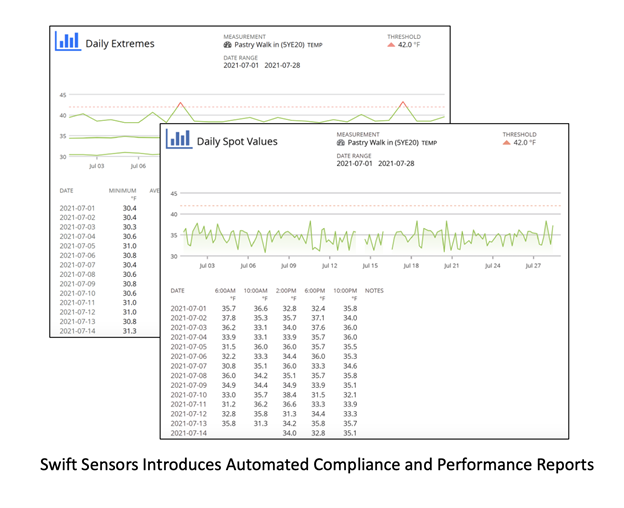Pass your next health inspection without relying on limited, overworked staff for logging
A key component of any quality assurance program is regular, disciplined monitoring and logging of critical control points. This is especially important when it comes to food safety inspections in the restaurant, catering, or institutional food service business. Keeping a vigilant eye on temperature ranges in storage refrigerators, freezers, and serving containers ensures that your raw materials and finished products are safe, high-quality, and delicious. All it takes is one freezer door left open, or a refrigeration unit to go down to waste thousands of dollars in inventory.
Kitchen staff, business owners, and health inspectors understand the importance of maintaining safe temperatures. Regular logging of refrigerator and storage temperatures is an important step in documenting food safety and equipment performance. Temperature log reports are a key element of formal HACCP quality programs. Logs are also an important deliverable for local city and county food inspections. Oftentimes, franchise operators are expected to provide these logs to corporate ownership as well to ensure quality standards are being met.
Taking a manual approach to creating temperature logs is more difficult than ever. Busy kitchen or wait staff are not able to reliably check and record temperatures at designated times. Hiring challenges in the hospitality industry today make it even more of a challenge. This is another reason that business owners are looking for automated cold chain monitoring and logging systems like Swift Sensors.
Generate Daily Compliance Reports On Demand
Swift Sensors introduced two new built-in reports to automate compliance documentation for common food safety certifications. With these reports, customers can document minimum, maximum, and average temperatures throughout the day or at specific times to validate conditions needed for safety and compliance.

As the global pandemic recedes and more establishments open, kitchen and wait staff are difficult to find and retain. Owners want their staff focused on the customer and food-related task at hand, rather than risk their important safety monitoring to human error. Customers using Swift Sensors Wireless Monitoring and Notification system in their refrigeration and freezer units, can now automatically generate a series of reports on-demand to meet these safety compliance requirements, which can then offer custom displays using our remote monitoring API.
Automate Your HACCP Reporting Requirements
These reports can be an integral part of a comprehensive Hazard Analysis Critical Control Point (HACCP) certification program. To comply, food service businesses must apply seven basic principles as outlined by the FDA to become certified:
- Conduct a Hazard Analysis
- Determine Critical Control Points
- Establish Critical Limits
- Establish Monitoring Procedures
- Establish Corrective Actions
- Establish Validation Procedures
- Establish record-keeping and documentation procedures
Swift Sensors can automate the temperature safety aspects of these programs by reinforcing critical limits with threshold notifications to drive corrective action, and now automated reporting and documentation.
Not Limited to Temperature Measurements
These new reports are not limited to temperature, nor are they limited to the Food Services industry. Any measurement can be included for documenting performance and compliance over an extended period. Laboratory and pharmaceutical companies must follow strict storage guidelines for temperature and humidity to ensure the safety and efficacy of vaccines, medicines, and tissue samples – made even more important as the Coronavirus vaccines have been introduced. Other businesses require environmental monitoring for the safety and comfort of employees and customers, remote school monitoring, or even remote livestock monitoring in some instances.
Learn more about these reports and how you can generate them from the Swift Sensors Cloud Software here –
